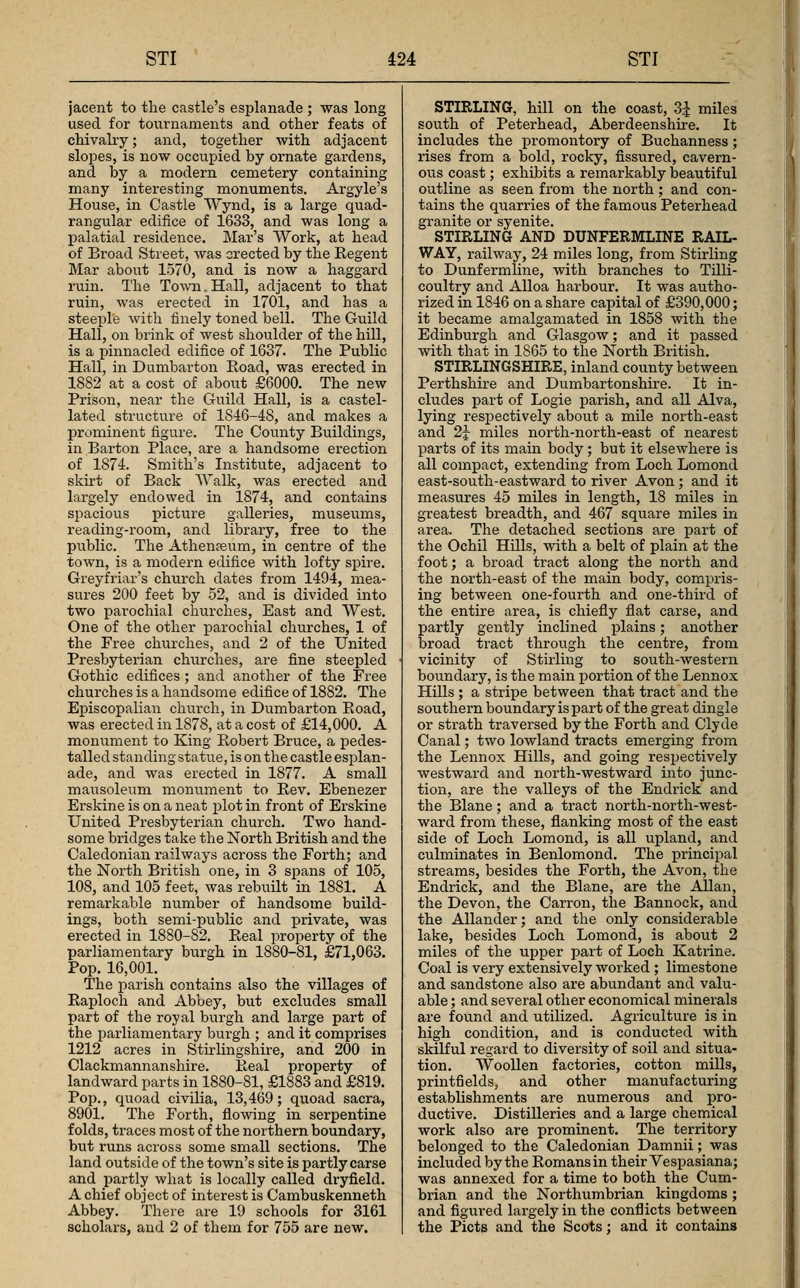STIRLING, hill on the coast, 3| miles south of Peterhead, Aberdeenshire. It includes the promontory of Buchanness ; rises from a bold, rocky, fissured, cavernous coast ; exhibits a remarkably beautiful outline as seen from the north ; and contains the quarries of the famous Peterhead granite or syenite.
STIRLING AND DUNFERMLINE RAILWAY, railway, 24 miles long, from Stirling to Dunfermline, with branches to Tillicoultry and Alloa harbour. It was autho-rized in 1846 on a share capital of 390,000 ; it became amalgamated in 1858 with the Edinburgh and Glasgow; and it passed with that in 1865 to the North British.
STIRLINGSHIRE, inland county between Perthshire and Dumbartonshire. It includes part of Logie parish, and all Alva, lying respectively about a mile north-east and 2J miles north-north-east of nearest parts of its main body ; but it elsewhere is all compact, extending from Loch Lomond east-south-eastward to river Avon ; and it measures 45 miles in length, 18 miles in greatest breadth, and 467 square miles in area. The detached sections are part of the Ochil Hills, with a belt of plain at the foot ; a broad tract along the north and the north-east of the main body, comprising between one-fourth and one-third of the entire area, is chiefly flat carse, and partly gently inclined plains ; another broad tract through the centre, from vicinity of Stirling to south-western boundary, is the main portion of the Lennox Hills ; a stripe between that tract and the southern boundary is part of the great dingle or strath traversed by the Forth and Clyde Canal ; two lowland tracts emerging from the Lennox Hills, and going respectively westward and north-westward into junction, are the valleys of the Endrick and the Blane; and a tract north-north-west-ward from these, flanking most of the east side of Loch Lomond, is all upland, and culminates in Benlomond. The principal streams, besides the Forth, the Avon, the Endrick, and the Blane, are the Allan, the Devon, the Carron, the Bannock, and the Allander; and the only considerable lake, besides Loch Lomond, is about 2 miles of the upper part of Loch Katrine. Coal is very extensively worked ; limestone and sandstone also are abundant and valuable ; and several other economical minerals are found and utilized. Agriculture is in high condition, and is conducted with skilful regard to diversity of soil and situation. "Woollen factories, cotton mills, printfields, and other manufacturing establishments are numerous and productive. Distilleries and a large chemical work also are prominent. The territory belonged to the Caledonian Damnii ; was included by the Romans in their Vespasiana; was annexed for a time to both the Cum-brian and the Northumbrian kingdoms ; and figured largely in the conflicts between the Picts and the Scots ; and it contains many interesting monuments of at once the Caledonian, the Roman, and the subsequent times. The towns with each more than 10,000 inhabitants are Stirling and Falkirk; with each more than 3000 are Kilsyth, Denny, Lennoxtown, and part of Bridge of Allan ; with each more than 2000 are Grangemouth, Bannockburn, and Milngavie ; with each more than 1000 are St. Ninians, Cambusbarron, Balfron, Stenhousemuir, Lauriston, and Carron Ironworks ; and the villages with each more than 300 amount to twenty-nine. Real property in 1880-81, 488,582. Pop. in 1871, 98,218 ; in 1881, 112,437.

